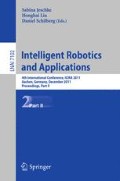Abstract
Manipulation of hazardous materials requires the use of robotics to limit exposure of human operators to the danger. In order to improve manipulator effectiveness while ensuring reliability and redundancy, layers of control are implemented in increments. Each level of autonomy is established such that should a fault occur, the control system can be operated at a lower level of autonomy. Force and torque data can be used as both a structural element of a level of autonomy and for fault detection. This paper presents a framework for the use of generalized force and torque data for improving manipulator safety, operational effectiveness, and world model augmentation. The framework is applied to a demonstration of the automated door opening.
Access this chapter
Tax calculation will be finalised at checkout
Purchases are for personal use only
Preview
Unable to display preview. Download preview PDF.
References
De Luca, A., Albu-Schaeffer, A., Haddadin, S., Hirzinger, G.: Collision Detection and Safe Reaction with the DLR-III Lightweight Manipulator Arm. In: IEEE/RSJ International Conference on Intelligent Robots and Systems, pp. 1623–1630 (2006)
Hanebeck, U., Fischer, C., Schmidt, G.: Roman: A mobile robotic assistant for indoor service applications. In: IROS 1997, vol. 2, pp. 518–525. IEEE, CS Press, Grenoble (June 1997)
Harden, T., Pittman, P.: Development of a Robotic System to Clean Out Spherical Dynamic Experiment Containment Vessels. In: American Nuclear Society EP&R and RR&S Topical Meeting, pp. 358–364. American Nuclear Society, Albuquerque (2008)
Jung, S., Hsia, T.S., Bonitz, R.: Force Tracking Impedance Control of Robot Manipulators Under Unknown Environment. IEEE Transactions on Control Systems Technology, 474–483 (2004)
Kulkarni, A., Kapoor, C., Pryor, M., Kinoshita, R., Bruemmer, D.: Software framework for mobile manipulation. In: ANS 2nd International Joint topical Meeting on Emergency Preparedness & Response and Robotics & Remote Systems, Albuquerque, NM (March 2008)
Lee, J.: Apply Force/Torque Sensors to Robotic Applications. Robotics, 189–194 (1987)
Lu, S., Chung, J., Valinsky, S.: Human-Robot Collision Detection and Identification Based on Wrist and Base Force/Torque Sensors. In: IEEE International Conference on Robotics and Automation, Barcelona, Spain, pp. 3796–3801 (2005)
Marks, P.: Robots with Skin Enter Our Touchy-Feely World. New Scientist (April 19, 2010)
Nagatani, K., Yuta, S.: Designing strategy and implementation of mobile manipulator control system for opening door. In: Proc. Of International Conference on Robotics and Automation., vol. 3, pp. 2828–2834 (1996)
Papakostas, T., Lima, J., Lowe, M.: A Large Area Force Sensor for Smart Skin Applications. IEEE Sensors, 1620–1624 (2002)
Petersson, L., Austin, D., Kragic, D.: High-Level Control of a Mobile Manipulator for Door Opening. In: Proceedings of the 2000 IEEE/RSJ International Conference on Intelligent Robots and Systems, pp. 2333–2338 (2000)
Radioisotope handling facilities and automation of radioisotope production. Technical report for the International Atomic Energy Agency. IAEA-TECDOC-1430 (December 2004)
Ralph, S., Pai, D.: Detection and Localization of Unmodeled Manipulator Collisions. In: IEEE International Conference on Intelligent Robots and Systems, Pittsburgh, Pennsylvania, pp. 504–509 (1995)
Roeder-Smith, L.: Pit Viper Strikes at the Hanford Site: Pit Maintenance Using Robotics at the Hanford Tank Farms. Radwaste Solutions, 33–39 (May/June 2002)
Sandia National Laboratories. ‘Mighty Mouse’ robot frees stuck radiation source (December 14, 2005), http://www.sandia.gov/news-center/news-releases/2005/manuf-tech-robotics/mm-robot.html
Seraji, H., Lim, D., Steele, R.: Experiments in Contact Control. Journal of Robotic Systems, 53–73 (1996)
Turner, C., Lloyd, J.: Actinide Research Quarterly—Automating ARIES (July 2008), http://www.lanl.gov/source/orgs/nmt/nmtdo/AQarchive/1st_2ndQuarter08/page8.shtml
Yoshikawa, T.: Force Control of Robot Manipulators. In: IEEE International Conference on Robotics and Automation, pp. 220–226. IEEE, San Francisco (2000)
Zeng, G., Hemami, A.: An Overview of Robot Force Control. Robotica, 473–482 (1997)
Editor information
Editors and Affiliations
Rights and permissions
Copyright information
© 2011 Springer-Verlag Berlin Heidelberg
About this paper
Cite this paper
Schroeder, K., Pryor, M. (2011). Framework for Use of Generalized Force and Torque Data in Transitional Levels of Autonomy. In: Jeschke, S., Liu, H., Schilberg, D. (eds) Intelligent Robotics and Applications. ICIRA 2011. Lecture Notes in Computer Science(), vol 7102. Springer, Berlin, Heidelberg. https://doi.org/10.1007/978-3-642-25489-5_43
Download citation
DOI: https://doi.org/10.1007/978-3-642-25489-5_43
Publisher Name: Springer, Berlin, Heidelberg
Print ISBN: 978-3-642-25488-8
Online ISBN: 978-3-642-25489-5
eBook Packages: Computer ScienceComputer Science (R0)

